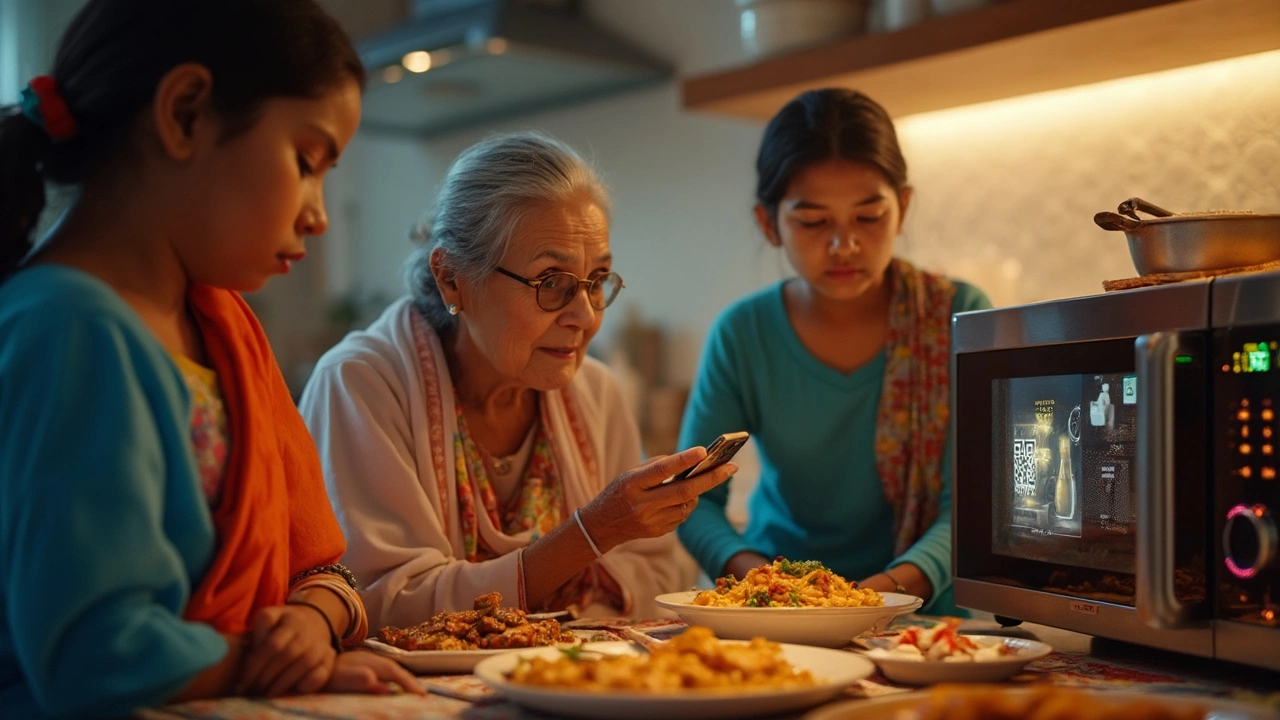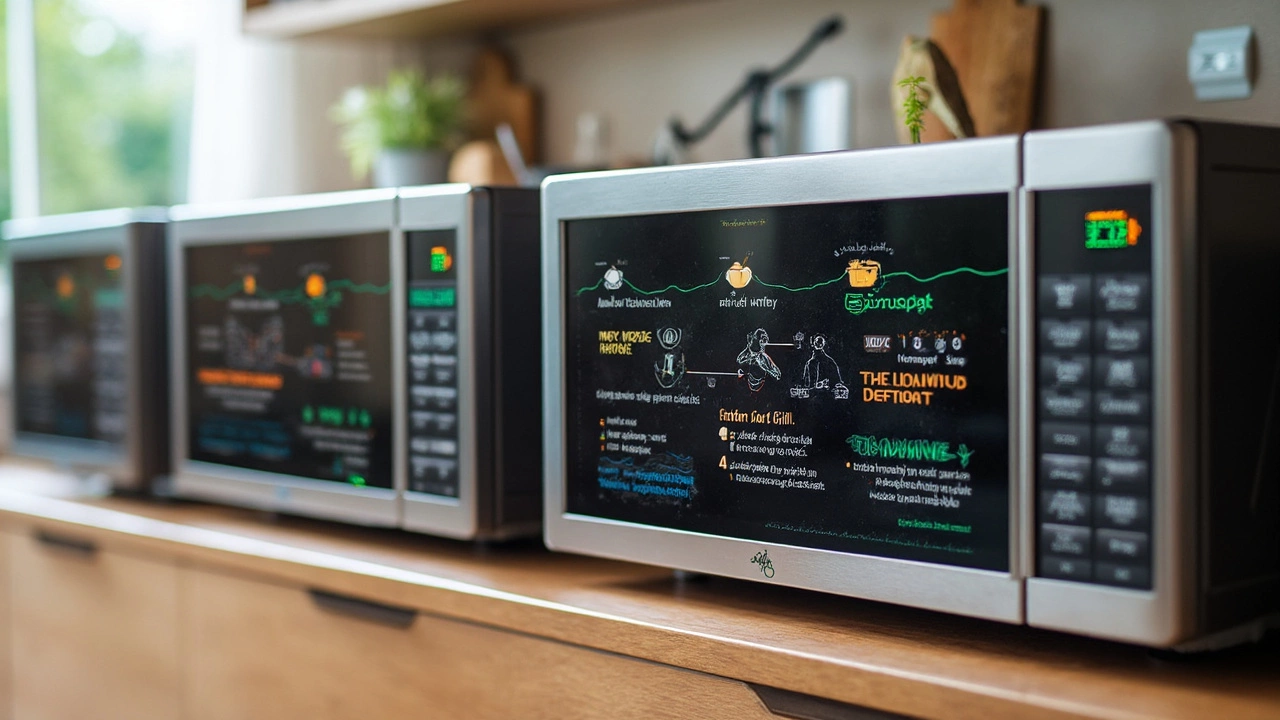
Have you ever stared at a microwave and wondered what half the buttons even do? You're not alone. Most people use just two or three features and ignore the rest. But microwaves can do way more than just heat leftovers or pop popcorn.
These days, even basic models have a pile of options packed in. There’s auto-defrost, express cook, child safety locks, and all sorts of shortcuts for common foods. Some even have power levels so you don’t nuke your coffee into oblivion. Fancy models go beyond that, adding sensors that check when your food’s done, or options for melting chocolate without turning it into a mess.
Not everything is as useful as it sounds, though. A ‘pizza’ button might sound great but works best as a rough guess, not a miracle worker. Some people buy the most expensive model thinking more buttons mean better meals—reality check: you’ll probably just use the basics 90% of the time.
- Core Functions You Actually Use
- Sensor Magic: Let the Microwave Do the Thinking
- Tech Extras You Didn’t Know Existed
- Choosing Features That Make Sense for You
Core Functions You Actually Use
If you look at the average kitchen, most folks stick to a handful of microwave features day after day. You'll almost always see the reheat and defrost buttons getting more action than anything else. The secret? These core features work with all sorts of foods and make everyday cooking easier, not just fancier.
The “cook time” and “power level” buttons are the backbone of every microwave oven. Cook time lets you pick exactly how long your food gets zapped. Power level actually controls how strong those waves hit your food. Cranking it up gets things done fast but can dry out or overcook. Dialing it down helps melt butter, soften bread, or keep leftovers from turning into rubber.
- Reheat: Built for leftovers. Most microwaves have auto-reheat settings that try to guess the right time and power. If your plate comes out half cold, it’s usually fine-tuning the power yourself that does the trick.
- Defrost: Quick-thaws frozen meat or bread, so you don’t have to wait hours. It works in short bursts so you don't half-cook the food. Most microwaves let you set weight for better accuracy.
- Express Cook: One-button starts for common times (like 30 seconds, 1 minute). Saves you a bunch of button presses when you’re in a rush.
- Popcorn and Potato: Pre-set modes for microwave classics. Not perfect every time, but usually beats guessing on your own. Just remember—these programs run by time, not by the bag size or potato type.
- Stop/Clear: Not glamorous, but a real lifesaver when things go sideways and you need to reset everything fast.
Ever wonder how much people actually use these functions? Check this out:
| Feature | Usage Rate (Typical Households) |
|---|---|
| Reheat | Up to 80% |
| Defrost | Roughly 40% |
| Express Cook | About 60% |
| Special Presets (Popcorn, Potato) | Less than 20% |
| Changing Power Level | Just 15% |
The bottom line? You’ll lean on reheat, defrost, and timed cooking way more than anything else. If you get those features dialed in, you’re golden. All the other bells and whistles? Nice to have, but not nearly as critical for everyday use.
Sensor Magic: Let the Microwave Do the Thinking
If you’ve ever nuked a frozen meal only to find the center colder than your fridge, sensor cooking is about to be your kitchen hero. These smart features let your microwave oven measure steam or humidity from food. Then, it adjusts the power and time on its own. All you usually do is hit a button, pick your food type, and the microwave takes over.
Here’s the cool part: it’s not just a timer. The microwave has built-in sensors that check how much moisture the food gives off as it heats up. More steam? That means it’s getting hotter, so the microwave knows when to ease off or stop completely. This is super handy for stuff like reheating leftovers, cooking veggies, potatoes, or reheating pizza without turning it into cardboard.
- Reheat: Put in your plate, press 'sensor reheat,' and forget it. The microwave checks the steam level and stops when your food’s actually hot—not just when the clock runs out.
- Frozen meals: No guessing at whether you’ve turned the middle into an ice cube or lava. Sensor cook smooths out the process.
- Popcorn: Sensors help stop the guessing game, so you don’t end up with burnt or half-popped kernels.
According to a 2023 consumer survey by Statista, over 45% of users with sensor microwaves said they used sensor features at least once a week. That’s a huge jump from back when everyone just set a random timer and hoped for the best.
| Food Type | Sensor Option | Benefit |
|---|---|---|
| Leftovers | Sensor Reheat | Even heating, stops automatically |
| Veggies | Sensor Cook | Keeps texture, avoids mushiness |
| Popcorn | Sensor Popcorn | Reduces burning, better pops |
| Baked Potatoes | Sensor Potato | Fluffy inside, no cold spots |
If you’re trying to decide if sensor features are worth it, think of the time and guesswork you save. And if your family likes variety—or you never remember the right heating time—letting the microwave figure it out can make weekday meals way less stressful.

Tech Extras You Didn’t Know Existed
If you think a microwave is just a box that heats stuff up, you’ll be surprised by the tech extras out there. Some of these features don’t get talked about much, but they can make a big difference to how you cook and what your microwave features list actually means for daily life.
First up: Inverter technology. This isn’t just a buzzword—microwaves with this feature can keep a steady cooking power, so food heats more evenly and isn’t lava-hot on one side and frozen on the other. If you’ve ever wrecked chicken by microwaving it, this one’s a game changer. Panasonic was one of the first brands to push inverters, but now it’s starting to pop up everywhere.
Then there’s convection mode. Microwaves with built-in convection can bake and roast as well as zap. People use these combo microwaves to bake cookies, roast veggies, or even do a small chicken. It’s perfect if your kitchen is tight on space and you want to ditch the big oven for small meals.
WiFi connectivity and smart home integration are popping up more and more. Some microwaves let you start or stop cooking from your phone, or even ask Alexa to reheat your coffee. There’s not much you can’t do remotely now, from getting notifications when food’s ready to scanning barcodes on packaged food so your microwave auto-sets the time and power. Whirlpool and GE are two brands rolling out these smart extras.
Don’t sleep on built-in steam clean functions either. Instead of scrubbing splatters, you can run a cleaning cycle that loosens up messes using steam. A quick wipe-down and you’re good. Also, some models have deodorizer fans to tackle the leftover smell of reheated fish.
- Quick-Start Buttons: Some microwaves offer “Add 30 Seconds” or “One-Touch Cook” functions to make things a lot faster.
- Child Lock: Essential for families, this stops curious kids from starting a hot mess—literally.
- Sound On/Off: A small feature, but being able to mute that annoying beep? Worth it.
It’s wild how many tech extras keep sneaking into modern microwaves. Some are really handy, some maybe just look cool, but knowing what’s out there lets you pick what you’ll actually use instead of paying for pointless bells and whistles.
Choosing Features That Make Sense for You
Before grabbing the microwave with the most buttons, think about how you actually use it. Are you just reheating pizza, or are you making meals from scratch? Most people only tap into a handful of functions, so buying based on your real habits makes sense.
Here's a quick breakdown of microwave features people use versus the flashy extras they often ignore:
| Feature | Regular Users (%) | Useful For... |
|---|---|---|
| Reheat/Quick Start | 94 | Everyday leftovers, drinks |
| Defrost | 82 | Frozen meat, veggies |
| Sensor Cooking | 41 | Auto adjusting cook time |
| Steam/Crisp Functions | 11 | Veggies, pizza, fries |
| Smartphone/App Controls | 6 | Remote start, reminders |
If you’re in a small space, a compact model with basic controls is usually enough. Busy households with kids? Look for a microwave with a good child lock and super simple controls. Someone who loves experimenting in the kitchen might really appreciate sensor cooking or multi-stage cooking options.
- If you’re short on counter space, check out under-cabinet or mountable models.
- Tired of exploding soup? Models with easy-clean interiors (like ceramic enamel) save you elbow grease.
- Want less beeping in your life? Some have a mute button, which is a game changer in households with babies or night owls.
Don't underestimate wattage — more power means faster, more even heating. For most kitchens, between 900 and 1100 watts does the trick. Lower power (600-800W) can leave food cold in the middle, while those ‘pro’ models at 1200W+ are for serious cooks or families who use the microwave a ton.
The point is, buy what makes your life easier — not just what looks cool on the box. If you’re mostly reheating food and defrosting stuff, save your cash and stick to the basics. But if you can’t stand lumpy oatmeal or rubbery leftovers, paying for sensor magic or a little more wattage might be worth it.